Destructive and Non-Destructive Analysis of Lightning-Induced Damage in Protected and Painted Composite Aircraft Laminates
Abstract
1. Introduction and State-of-the-Art
1.1. Lightning Direct Damage on Composite Laminates
1.2. Damage Limitation with Lightning Strike Protection Technologies
1.3. Paint Effect
2. Damage Source Decomposition on Real Aircraft Structure: The Proposed Hypothesis
3. Materials and Methods
3.1. Specimen Preparation
3.2. Experimental Study
3.3. Damage Measurement Methods
3.4. Two-Dimensional and 3D Delamination Mesurement from Cuttings
4. Results and Discussion
4.1. Two-Dimensional and 3D Delamination Reconstruction Result
4.2. Core Current Flow-Induced Damage
4.3. Core Current Flow-Induced Mechanical Load
4.4. Mechanical Damage Extension Due to Surface Explosion: Paint Effect
5. Conclusions
Author Contributions
Funding
Data Availability Statement
Acknowledgments
Conflicts of Interest
References
- Feraboli, P.; Miller, M. Damage resistance and tolerance of carbon/epoxy composite coupons subjected to simulated lightning strike. Compos. Part A Appl. Sci. Manuf. 2009, 40, 954–967. [Google Scholar] [CrossRef]
- Hirano, Y.; Yokozeki, T.; Ishida, Y.; Goto, T.; Takahashi, T.; Qian, D.; Ito, S.; Ogasawara, T.; Ishibashi, M. Lightning damage suppression in a carbon fiber-reinforced polymer with a polyaniline-based conductive thermoset matrix. Comp. Sci. Tech. 2016, 127, 1–7. [Google Scholar] [CrossRef]
- Matsuo, S.; Sottos, N.R. Single carbon fiber transverse electrical resistivity measurement via the van der Pauw method. J. Appl. Phys. 2021, 130, 115105. [Google Scholar] [CrossRef]
- Yousefpour, K.; Lin, W.; Wang, Y.; Park, C. Modeling Discharge and ground electrode design considerations for the lightning strike damage tolerance assessment of CFRP matrix composite laminates. Compos. Part B Eng. 2020, 198, 108226. [Google Scholar] [CrossRef]
- Duongthipthewa, A.; Tian, Y.; Duongthipthewa, O.; Su, Z.; Zhou, L. A comprehensive analysis of electric, thermal, and structural effects of lightning strikes on CFRP composites and protective strategies. Comp. Comm. 2023, 44, 101739. [Google Scholar] [CrossRef]
- Li, S.; Sun, J.; Guo, Y.; Li, Y.; Wang, B.; Zhu, Y.; Li, M.; Yao, X. Analysis of the damage effects of carbon fiber composites under the mechanical impact loads of lightning based on a modified simulation calculation method. Compos. Part B Eng. 2024, 238, 111644. [Google Scholar] [CrossRef]
- Das, S.; Yokozeki, T. A brief review of modified conductive carbon/glass fibre reinforced composites for structural applications: Lightning strike protection, electromagnetic shielding, and strain sensing. Compos. Part C Open Access 2021, 5, 100162. [Google Scholar] [CrossRef]
- Munoz, R.; Delgado, S.; Gonzalez, C.; Lopez-Romano, B.; Wang, D.-Y.; LLorca, J. Modeling Lightning Impact Thermo-Mechanical Damage on Composite Materials. Appl. Compos. Mater. 2014, 21, 149–164. [Google Scholar] [CrossRef]
- Kumar, V.; Lin, W.; Wang, Y.; Spencer, R.; Saha, S.; Park, C.; Yeole, P.; Hmeidat, N.S.; Herring, C.; Rencheck, M.L.; et al. Enhanced through-thickness electrical conductivity and lightning strike damage response of interleaved vertically aligned short carbon fiber composites. Compos. Part B Eng. 2023, 253, 110535. [Google Scholar] [CrossRef]
- Chemartin, L.; Lalande, P.; Peyrou, B.; Chazottes, A.; Elias, P.Q.; Delalondre, C.; Cheron, B.G.; Lago, F. Direct Effects of Lightning on Aircraft Structure: Analysis of the Thermal, Electrical and Mechanical Constraints. AerospaceLab 2012, 5, 1–15. [Google Scholar]
- Jia, A.; Wang, F.; Xu, B.; Yan, W. A developed energy-dependent model for studying thermal shock damage and phase transition of composite reinforced panel subjected to lightning strike. Eur. J. Mech.—A/Solids 2021, 85, 104141. [Google Scholar] [CrossRef]
- Wang, Y.; Fan, Y.; Zhupanska, O.I. Challenges and Future Recommendations for Lightning Strike Damage Assessments of Composites: Laboratory Testing and Predictive Modeling. Materials 2024, 17, 744. [Google Scholar] [CrossRef]
- EUROCAE. ED-84; Aircraft Lightning Environment and Related Test Waveforms. GlobalSpec: Saint-Denis, France, 2013. Available online: https://www.eurocae.net/product/ed-84a-aircraft-lightning-environment-and-related-waveforms/ (accessed on 12 May 2025).
- Hirano, Y.; Katsumata, S.; Iwahori, Y.; Todoroki, A. Artificial lightning testing on graphite/epoxy composite laminate. Compos. Part A Appl. Sci. Manuf. 2010, 41, 1467–1470. [Google Scholar] [CrossRef]
- Li, Y.; Li, R.; Lu, L.; Huangv, X. Experimental study of damage characteristics of carbon woven fabric/epoxy laminates subjected to lightning strike. Compos. Part A Appl. Sci. Manuf. 2015, 79, 164–175. [Google Scholar] [CrossRef]
- Sun, J.; Yao, X.; Tian, X.; Chen, J.; Wu, Y. Damage Characteristics of CFRP Laminates Subjected to Multiple Lightning Current Strike. Appl Compos Mater 2019, 26, 745–762. [Google Scholar] [CrossRef]
- Abdelal, G.; Murphy, A. Nonlinear numerical modelling of lightning strike effect on composite panels with temperature dependent material properties. Comp. Struc. 2014, 109, 268–278. [Google Scholar] [CrossRef]
- Karch, C.; Honke, R.; Steinwandel, J.; Dittrich, K.W. Contributions of lightning current pulses to mechanical damage of CFRP structures. In Proceedings of the International Conference on Lightning & Static Electricity (ICOLSE 2015), Toulouse, France, 9–11 September 2015. [Google Scholar] [CrossRef]
- Foster, P.; Abdelal, G.; Murphy, A. Understanding how arc attachment behaviour influences the prediction of composite specimen thermal loading during an artificial lightning strike test. Comp. Struc. 2018, 192, 671–683. [Google Scholar] [CrossRef]
- Soulas, F.; Espinosa, C.; Lachaud, F.; Guinard, S.; Lepetit, B.; Revel, I.; Duval, Y. A method to replace lightning strike tests by ball impacts in the design process of lightweight composite. Int. J. Imp. Eng. 2018, 111, 165–176. [Google Scholar] [CrossRef]
- Dong, Q.; Guo, Y.; Chen, J.; Yao, X.; Yi, X.; Ping, L.; Jia, Y. Influencing factor analysis based on electrical–thermal-pyrolytic simulation of carbon fiber composites lightning damage. Comp. Struc. 2016, 140, 1–10. [Google Scholar] [CrossRef]
- Karch, C.; Metzner, C. Lightning protection of carbon fibre reinforced plastics—An overview. In Proceedings of the 33rd International Conference on Lightning Protection (ICLP 2016), Estoril, Portugal, 25–30 September 2016. [Google Scholar] [CrossRef]
- Gagné, M.; Therriault, D. Lightning strike protection of composites. Prog. Aerosp. Sci. 2014, 64, 1–16. [Google Scholar] [CrossRef]
- Bigand, A.; Duval, Y. Quantification of the mechanical impact of lightning strike protection explosion confined by thick paint. In Proceedings of the International Conference on Lightning & Static Electricity (ICOLSE 2017), Winc Aichi, Nagoya, Aichi, Japan, 13–15 September 2017; Available online: https://hal.science/hal-03234731/document (accessed on 12 May 2025).
- Yi, X. Research on lightning protection metal mesh for wind turbine blades. In Proceedings of the 2nd International Conference on Sustainable Technology and Management (ICSTM 2023), Dongguan, China, 21–23 July 2023. [Google Scholar] [CrossRef]
- Russ, M.; Rahatekar, S.; Koziol, K.; Peng, H.X.; Farmer, B. Development of carbon nanotube/epoxy nanocomposites for lightning strike protection. In Proceedings of the 18th International Conference on Composite Materials (ICCM), Jeju, Republic of Korea, 21–26 August 2011; Available online: https://research-information.bris.ac.uk/en/publications/development-of-carbon-nanotubeepoxy-nanocomposites-for-lightning- (accessed on 12 May 2025).
- Kumar, V.; Yokozeki, T.; Karch, C.; Hassen, A.A.; Hershey, C.J.; Kim, S.; Lindahl, J.M.; Barnes, A.; Bandari, Y.K.; Kunc, V. Factors affecting direct lightning strike damage to fiber reinforced composites: A review. Compos. Part B Eng. 2020, 183, 107688. [Google Scholar] [CrossRef]
- Guo, Y.; Xu, Y.; Wang, Q.; Dong, Q.; Yi, X.; Jia, Y. Enhanced lightning strike protection of carbon fiber composites using expanded foils with anisotropic electrical conductivity. Compos. Part A Appl. Sci. Manuf. 2019, 117, 211–218. [Google Scholar] [CrossRef]
- Sousa Martins, R. Experimental and Theoretical Studies of Lightning Arcs and Their Interaction with Aeronautical Materials. Ph.D. Thesis, Université PARIS-SACLAY, Paris, France, 2016. Available online: https://hal.science/tel-01434026v1 (accessed on 12 May 2025).
- Bigand, A.; Espinosa, C.; Bauchire, J.-M. Lightning surface explosion impact study on damage generation into composite. In Proceedings of the International Conference on Lightning & Static Electricity (ICOLSE 2019), Wichita Area Technical College, Wichita, KS, USA, 10–13 September 2019; Available online: https://hal.science/hal-02391647 (accessed on 12 May 2025).
- Espinosa, C.; Bhoosnurmath, H.; CLópez, A.; Lachaud, F. Numerical Modelling of a Lightning Strike on a Protected Composite Panel. In Proceedings of the International Conference on Lightning & Static Electricity (ICOLSE 2017), Winc Aichi, Nagoya, Aichi, Japan, 13–15 September 2017; Available online: https://hal.science/hal-02044384v1/document (accessed on 14 May 2025).
- Lepetit, B.; Escure, C.; Guinard, S.; Revel, I.; Peres, G. Thermo-mechanical effects induced by lightning on carbon fiber composite materials. In Proceedings of the International Conference on Lightning and Static Electricity (ICOLSE 2011), Oxford, UK, 6–9 September 2011; Available online: https://api.semanticscholar.org/CorpusID:210910432 (accessed on 14 May 2025).
- Bigand, A.; Espinosa, C.; Bauchire, J.-M.; Flourens, F.; Lachaud, F. Lightning damage assessment into composite based on surface explosion and fiber breakage. In Proceedings of the 22nd International Conference on Composite Materials (ICCM2), Melbourne, Australia, 11–16 August 2019; Available online: https://hal.science/hal-02392778v1 (accessed on 12 May 2025).
- Millen, S.L.J.; Ashworth, S.; Farrell, C.; Murphy, A. Understanding and representing heating and heating rate effects on composite material properties for lightning strike direct effect simulations. Compos. Part B Eng. 2022, 228, 109438. [Google Scholar] [CrossRef]
- Li, S.; Wang, A.; Sun, J.; Jiang, Z.; Guo, Y.; Yao, X. Quantitative Experimental Study of Mechanical Effects of Carbon Fiber Composites under Impulse Lightning Current. In Proceedings of the 2024 IEEE International Conference on High Voltage Engineering and Applications (ICHVE 2024), Berlin, Germany; 2024; pp. 1–3. [Google Scholar] [CrossRef]
- Lepetit, B.; Soulas, F.; Guinard, S.; Revel, I.; Peres, G. Analysis of composite panel damages due to a lightning strike: Mechanical effects. In Proceedings of the International Conference on Lightning & Static Electricity (ICOLSE 2013), Seattle, WA, USA, 18–20 September 2013. [Google Scholar]
- Rannou, J.; Huchette, C.; Hurmane, A.; Tholin, F. An analysis of lightning direct effects on CFRP panels. Part II, the electro-thermo-mechanical simulation strategy. In Proceedings of the International Conference on Lightning & Static Electricity (ICOLSE 2017), Winc Aichi, Nagoya, Aichi, Japan, 13–15 September 2017. [Google Scholar]
- Huchette, C.; Rannou, J.; Roche, J.; Lapeyronnie, P.; Beauchêne, P.; Chemartin, L. An analysis of lightning direct effects on CFRP panels. Part I, the experimental and material point of view. In Proceedings of the International Conference on Lightning & Static Electricity (ICOLSE 2017), Winc Aichi, Nagoya, Aichi, Japan, 13–15 September 2017. [Google Scholar]
- Bigand, A.; Bauchire, J.-M.; Espinosa, C. Lightning arc interaction with complex structure. In Proceedings of the 15th International High-Tech Plasma Processes Conference (HTPP), Toulouse, France, 2–6 July 2018; Available online: https://hal.science/hal-02152731 (accessed on 12 May 2025).
- EUROCAE. ED-105; Aircraft Lightning Test Methods. GlobalSpec: Albany, NY, USA, 2013. Available online: https://standards.globalspec.com/std/1637778/eurocae-ed-105 (accessed on 12 May 2025).
- Bigand, A.; Espinosa, C.; Bauchire, J.-M. Equivalent mechanical load model methodology to simulate lightning strike impact on protected and painted composite structure. Electr. Power Syst. Res. 2023, 217, 114886. [Google Scholar] [CrossRef]
- Guo, Y.; Xu, Y.; Zhang, L.; Wei, X.; Dong, Q.; Yi, X.; Jia, X. Implementation of fiberglass in carbon fiber composites as an isolation layer that enhances lightning strike protection. Comp. Sci. Tech. 2019, 174, 117–124. [Google Scholar] [CrossRef]
- Bigand, A.; Revel, I.; Hascoet, V.; Nacelles, S. Lightning current transfer risk assessment after skin puncture. In Proceedings of the International Conference on Lightning & Static Electricity (ICOLSE 2019), Wichita Area Technical College, Wichita, KS, USA, 10–13 September 2019. [Google Scholar]
- Guo, Y.; Dong, Q.; Chen, J.; Yao, X.; Yi, X.; Jia, Y. Comparison between temperature and pyrolysis dependent models to evaluate the lightning strike damage of carbon fiber composite laminates. Compos. Part A Appl. Sci. Manuf. 2017, 97, 10–18. [Google Scholar] [CrossRef]

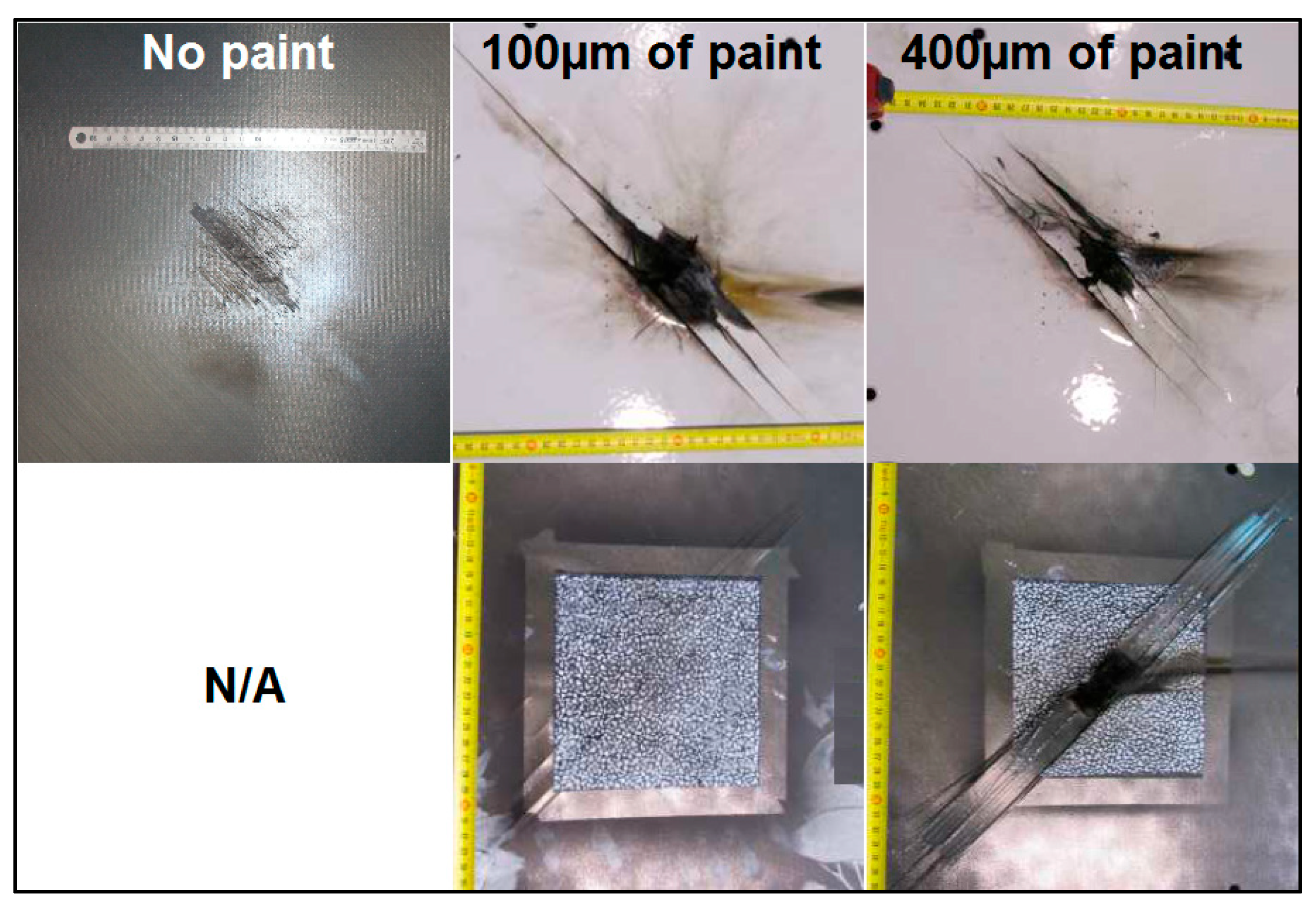
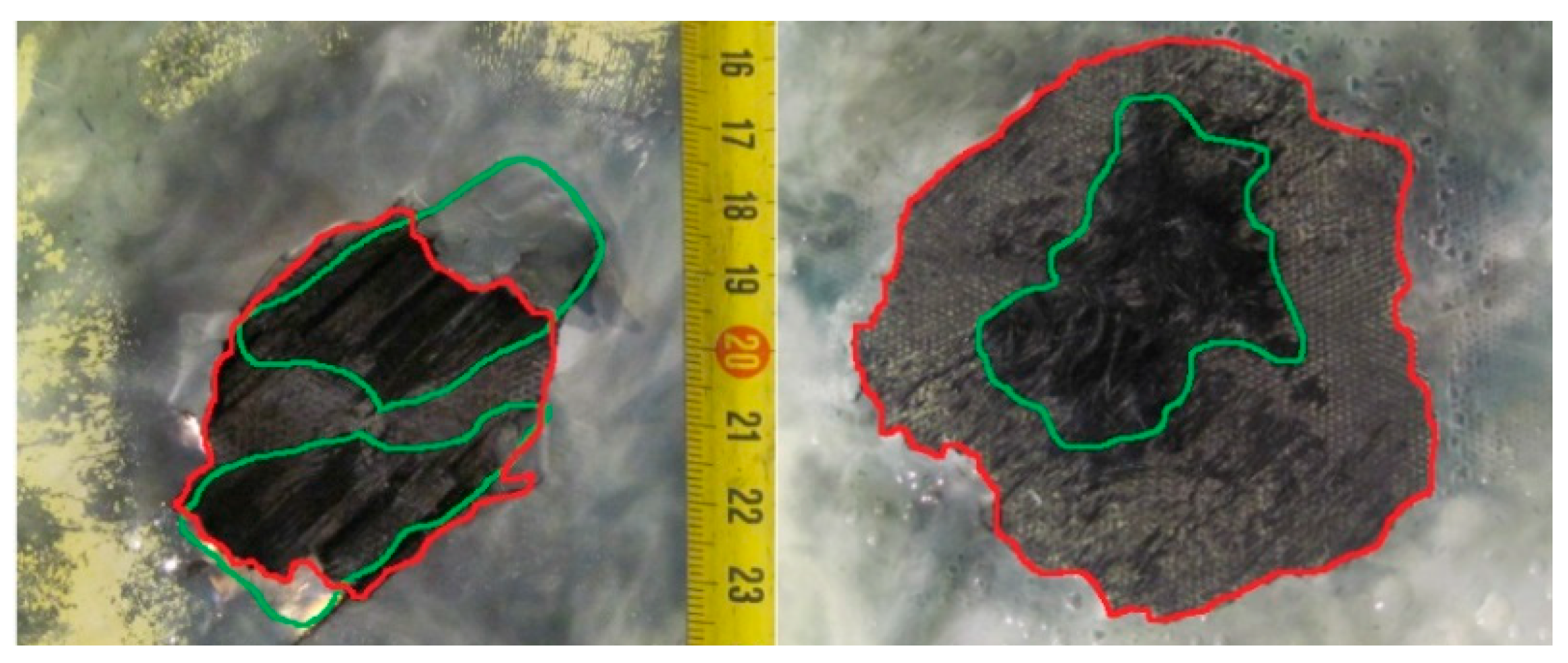

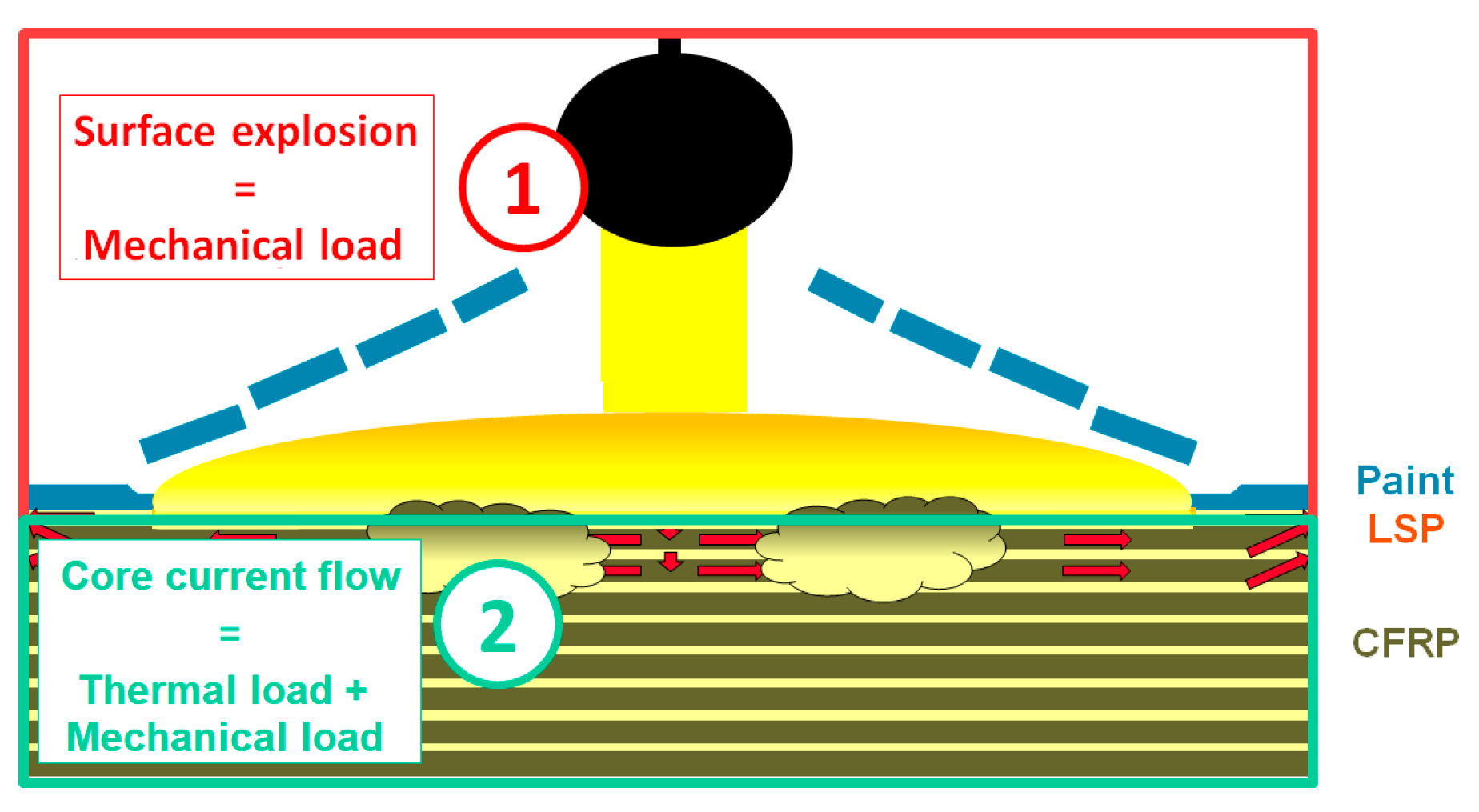
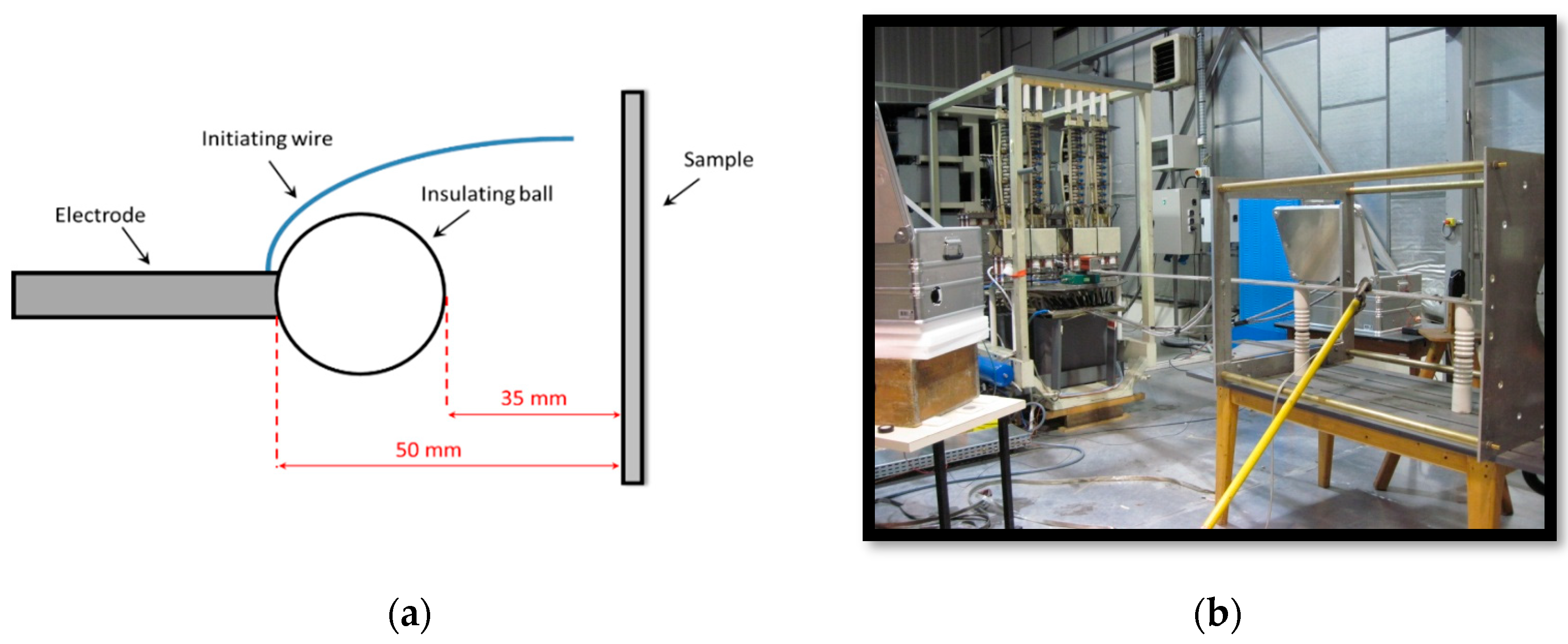
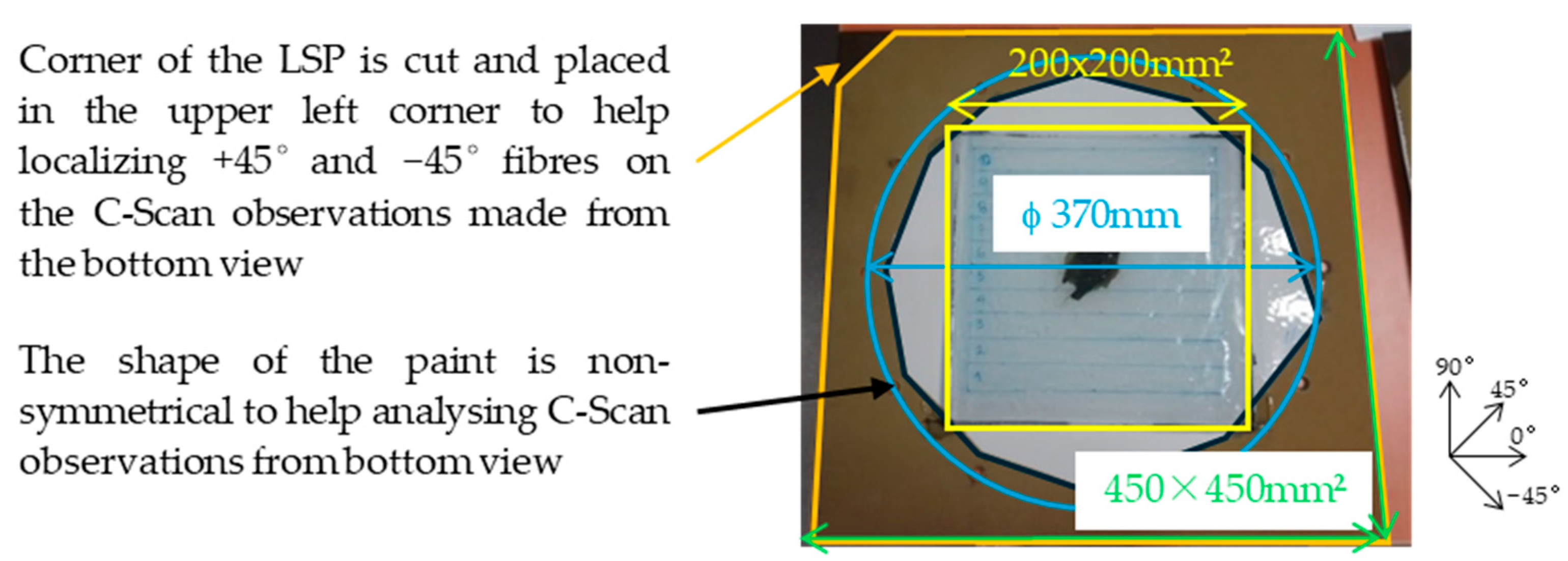


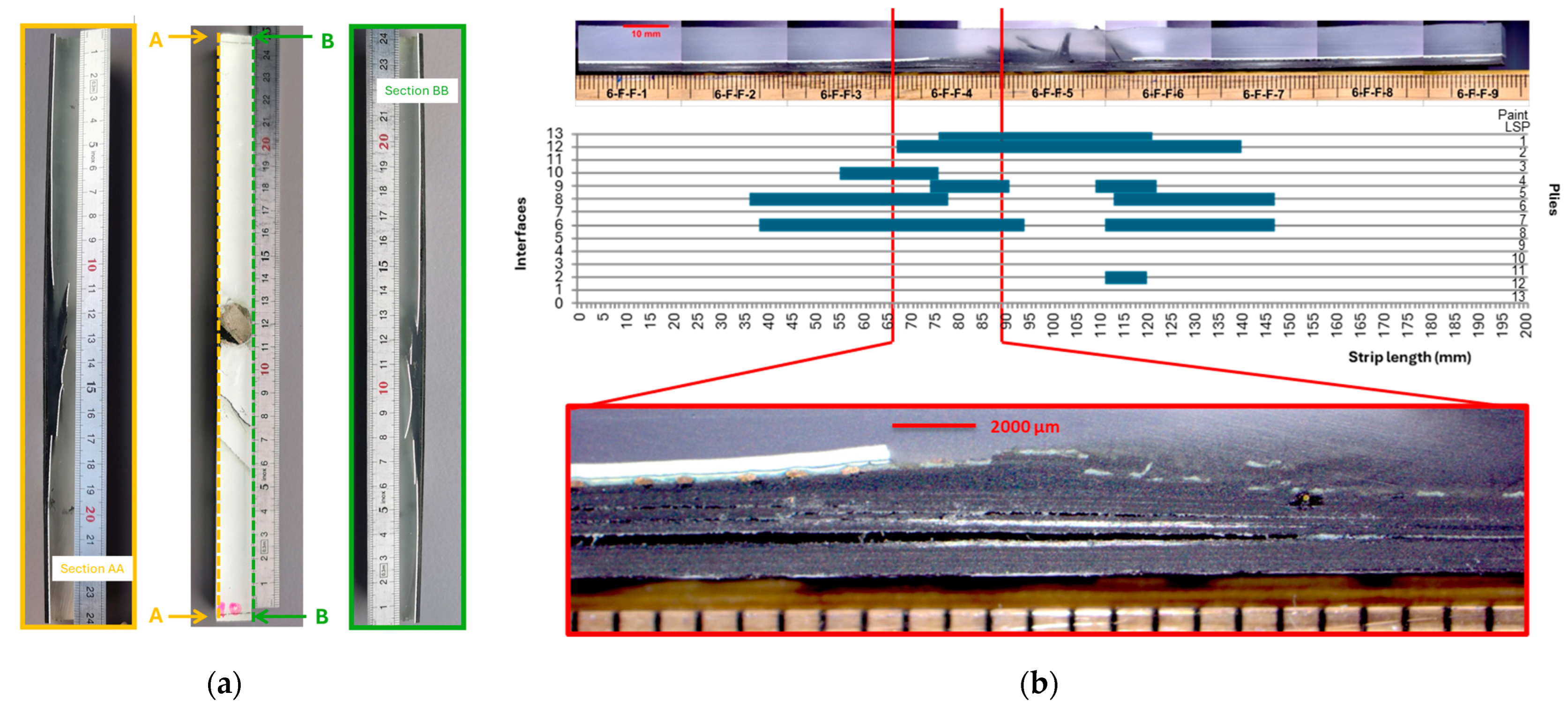
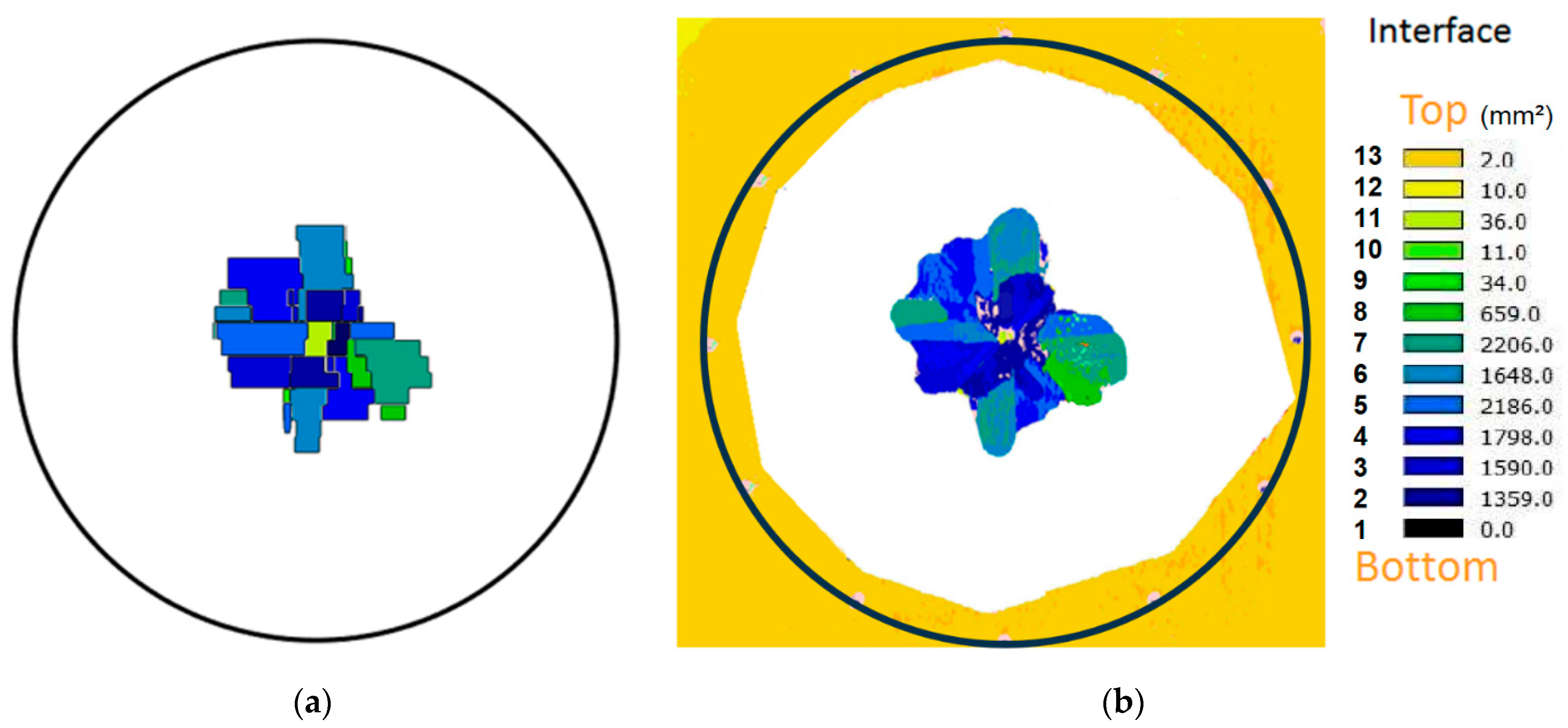
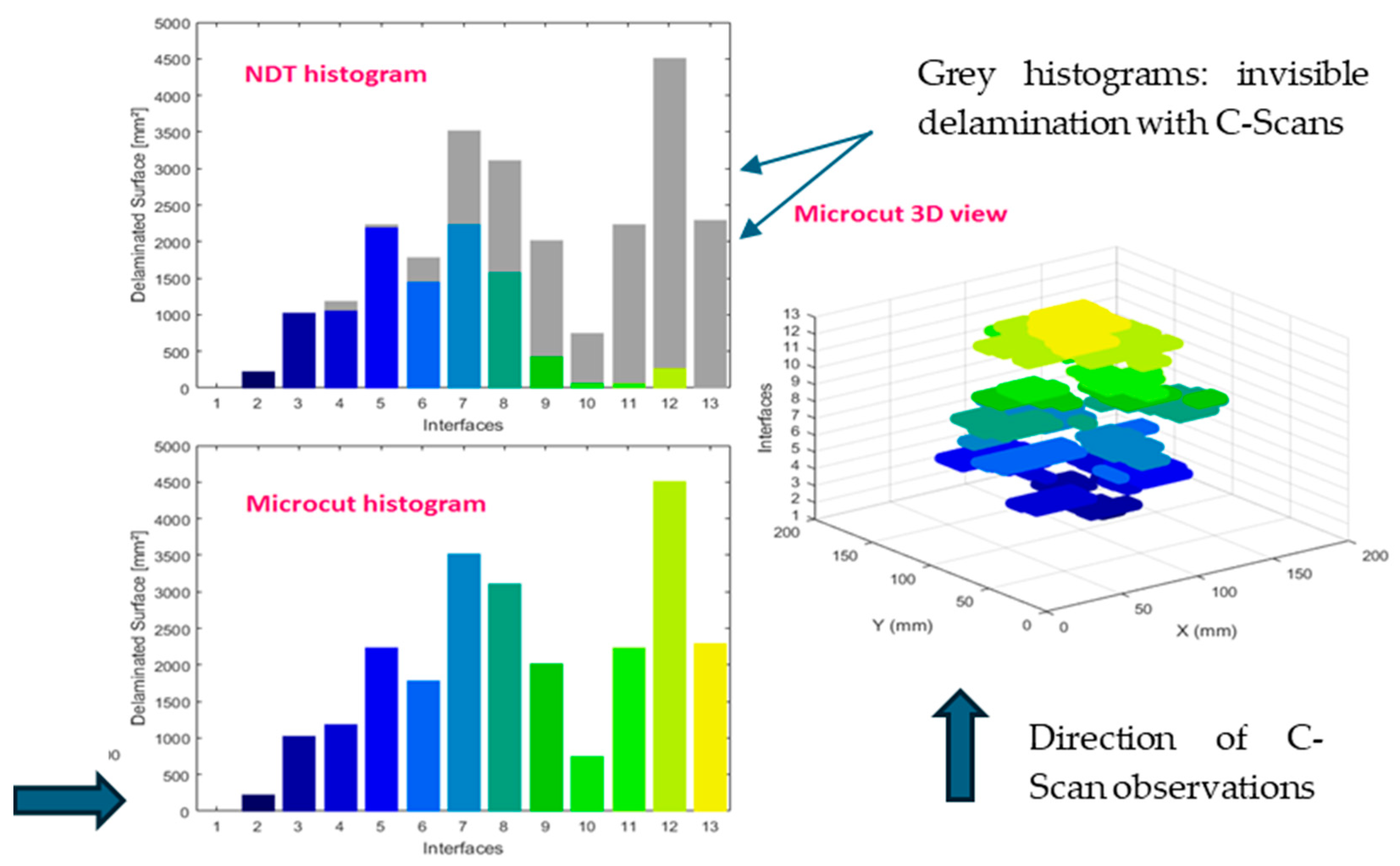


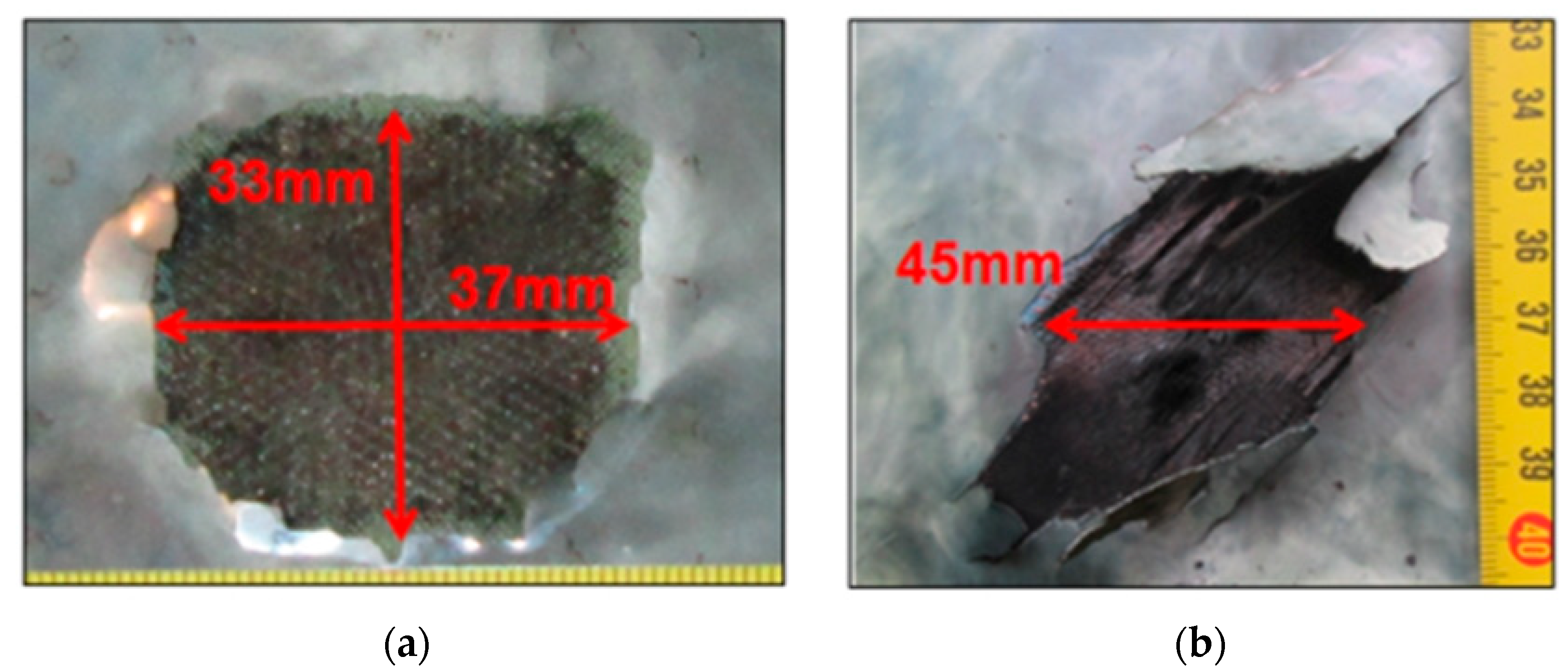
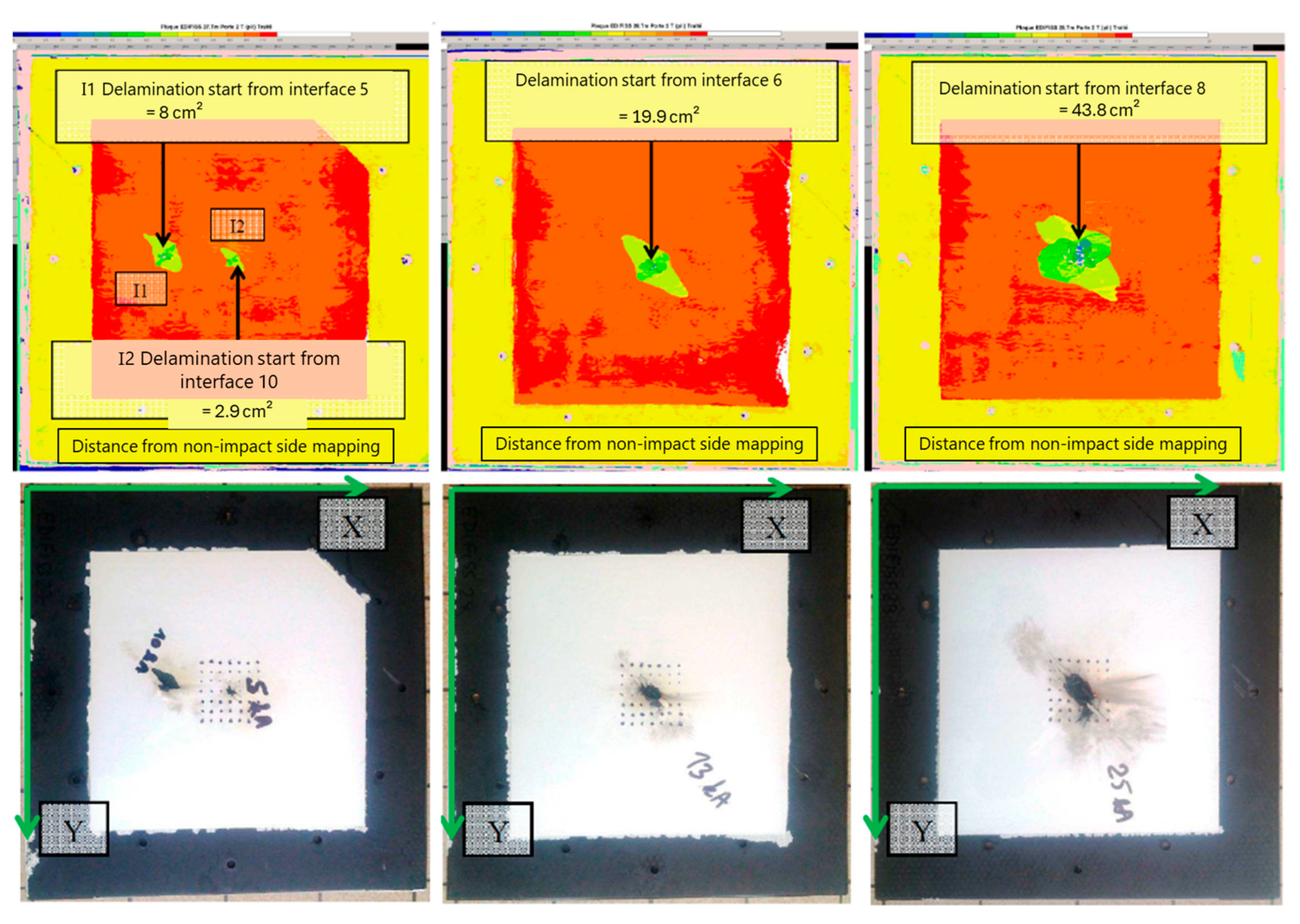
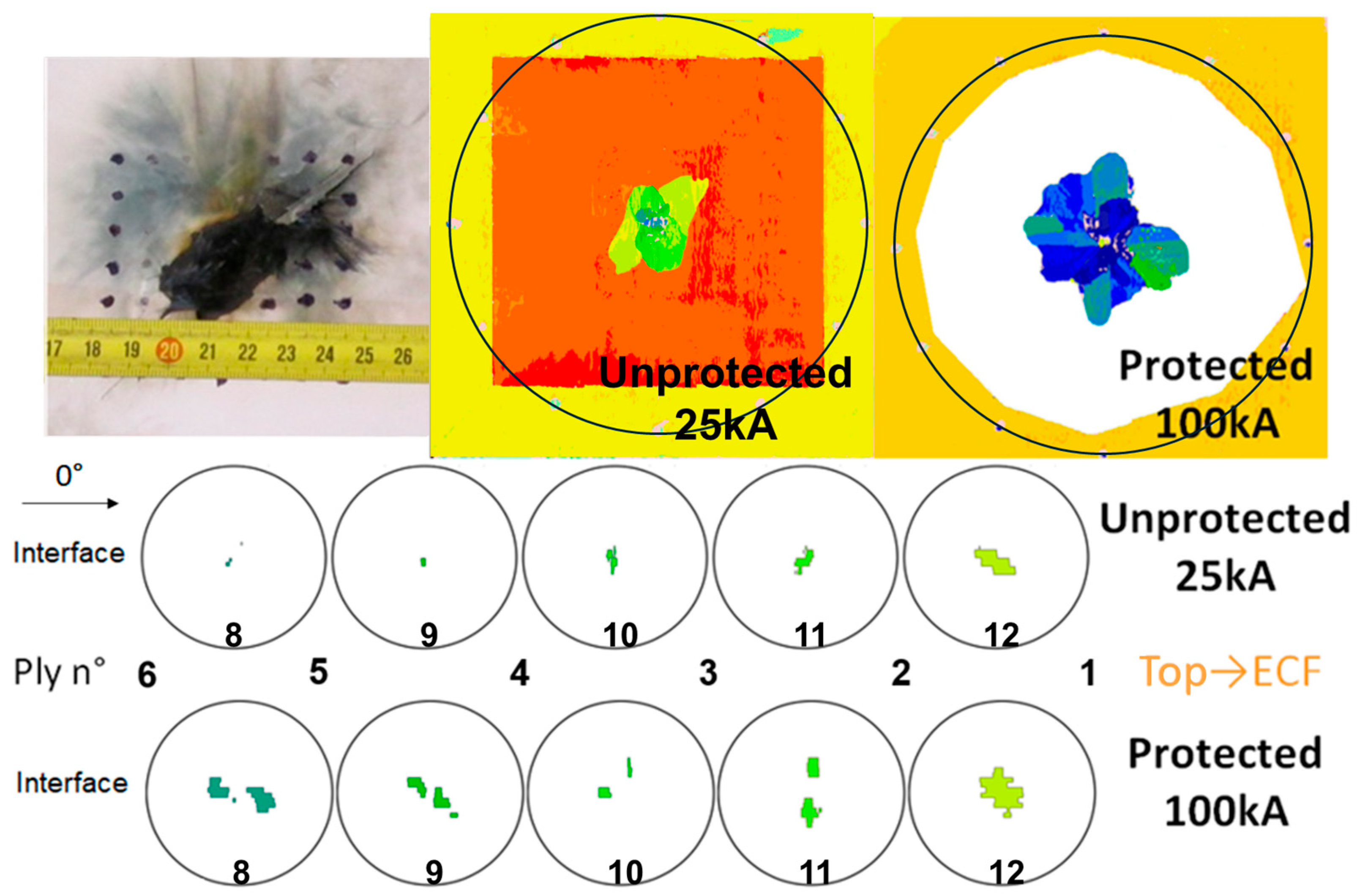
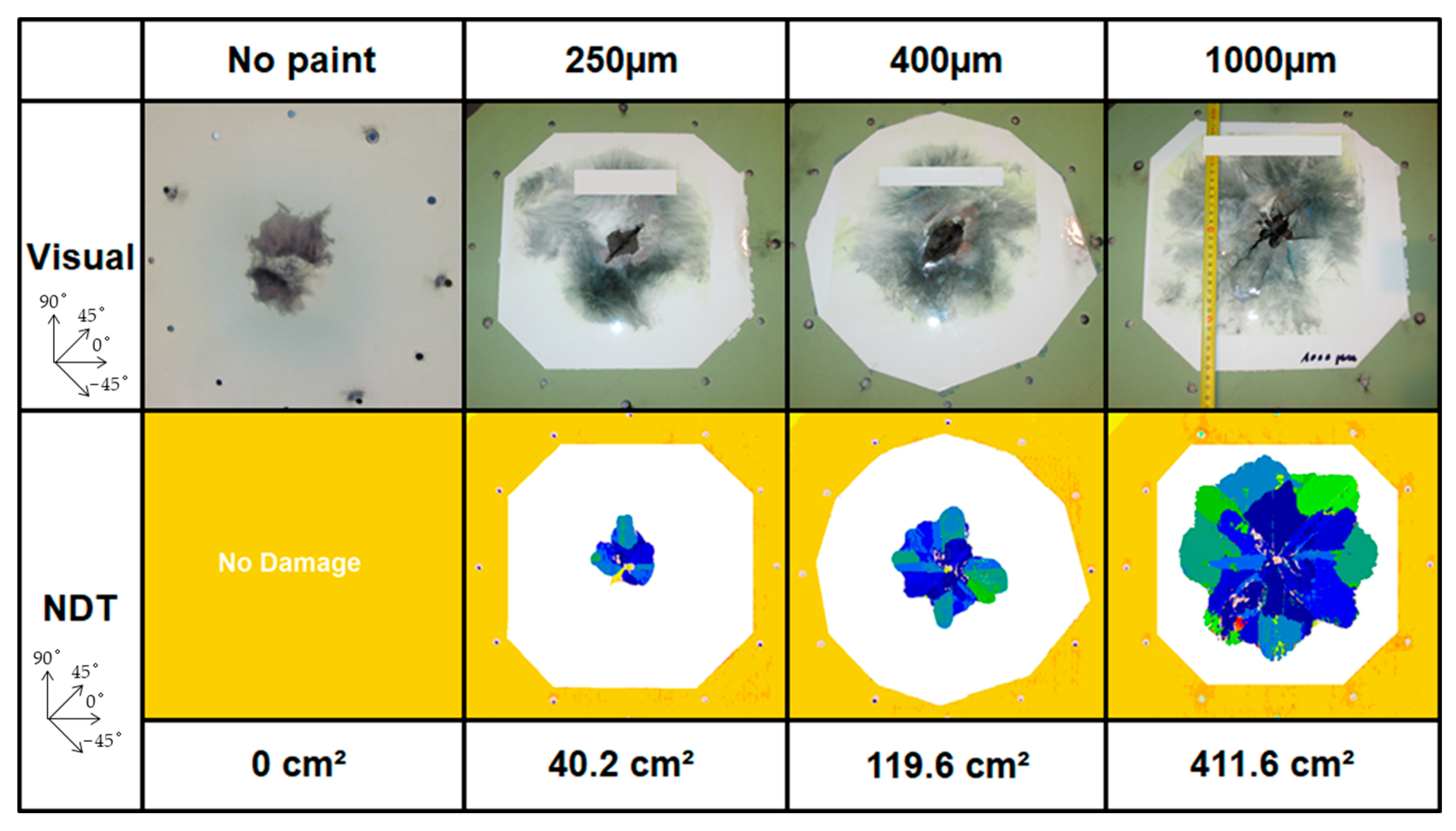
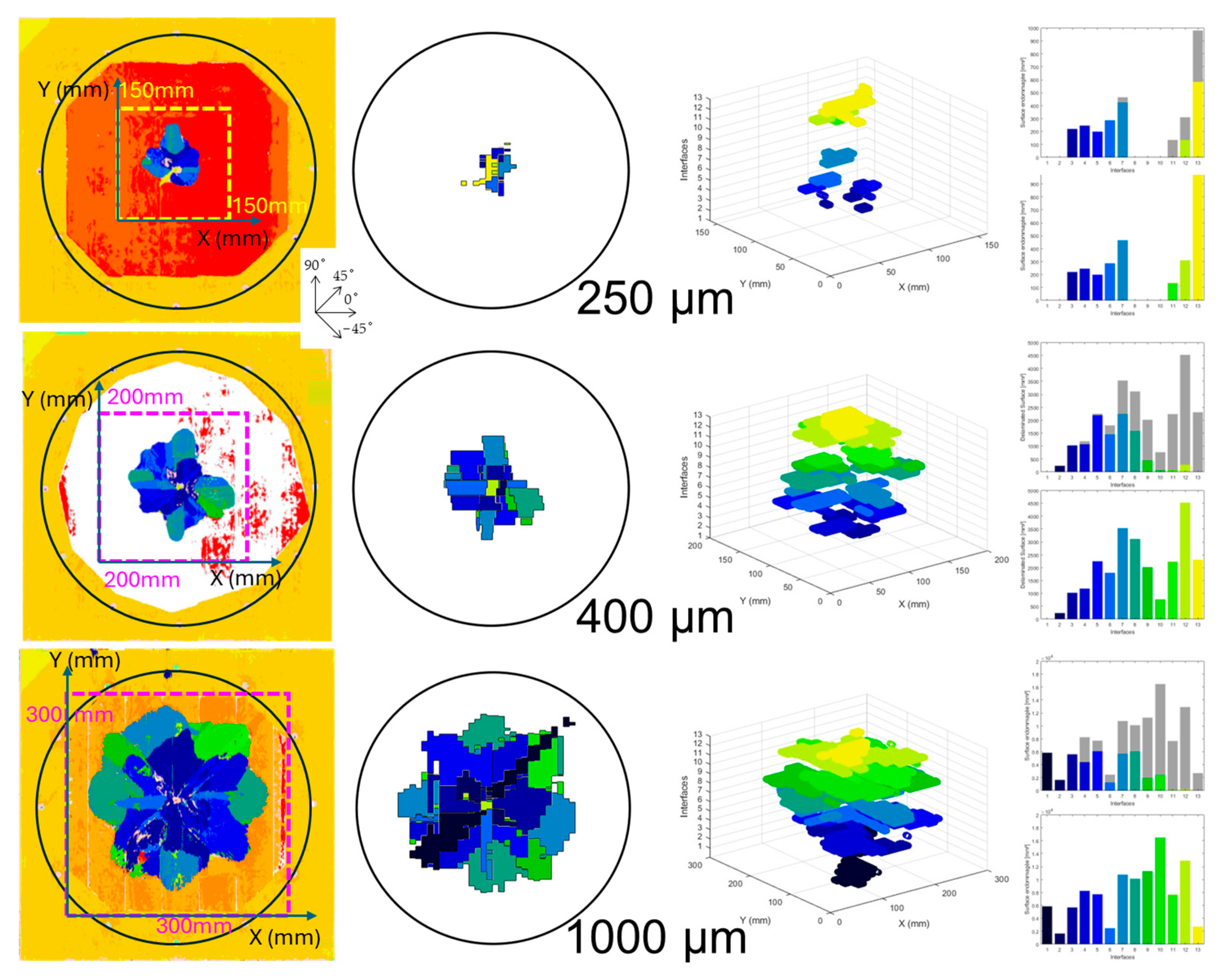

| Rationale | N° Sample | LSP | Paint Thickness (µm) | Peak Current kA |
|---|---|---|---|---|
| CFRP Composite damage baseline | 1 | ECF195 | 400 | 100 |
| CFRP Composite damage with internal explosion and extreme surface confinement | 2 | ECF195 | 1000 | 100 |
| CFRP Composite damage with internal explosion and light surface confinement | 3 | ECF195 | 250 | 100 |
| Thermal damage due to full current in the LSP and no current in the GFRP | 4 | ECF195 | 400 | 100 |
| CFRP Composite thermal damage produced by current diving from top ply | 5 | No | 400 | 5 |
| CFRP Composite thermal damage produced by current diving from top ply | 6 | No | 400 | 13 |
| CFRP Composite thermal damage produced by current diving from top ply | 7 | No | 400 | 25 |
Disclaimer/Publisher’s Note: The statements, opinions and data contained in all publications are solely those of the individual author(s) and contributor(s) and not of MDPI and/or the editor(s). MDPI and/or the editor(s) disclaim responsibility for any injury to people or property resulting from any ideas, methods, instructions or products referred to in the content. |
© 2025 by the authors. Licensee MDPI, Basel, Switzerland. This article is an open access article distributed under the terms and conditions of the Creative Commons Attribution (CC BY) license (https://creativecommons.org/licenses/by/4.0/).
Share and Cite
Bigand, A.; Espinosa, C.; Bauchire, J.-M. Destructive and Non-Destructive Analysis of Lightning-Induced Damage in Protected and Painted Composite Aircraft Laminates. Aerospace 2025, 12, 446. https://doi.org/10.3390/aerospace12050446
Bigand A, Espinosa C, Bauchire J-M. Destructive and Non-Destructive Analysis of Lightning-Induced Damage in Protected and Painted Composite Aircraft Laminates. Aerospace. 2025; 12(5):446. https://doi.org/10.3390/aerospace12050446
Chicago/Turabian StyleBigand, Audrey, Christine Espinosa, and Jean-Marc Bauchire. 2025. "Destructive and Non-Destructive Analysis of Lightning-Induced Damage in Protected and Painted Composite Aircraft Laminates" Aerospace 12, no. 5: 446. https://doi.org/10.3390/aerospace12050446
APA StyleBigand, A., Espinosa, C., & Bauchire, J.-M. (2025). Destructive and Non-Destructive Analysis of Lightning-Induced Damage in Protected and Painted Composite Aircraft Laminates. Aerospace, 12(5), 446. https://doi.org/10.3390/aerospace12050446






